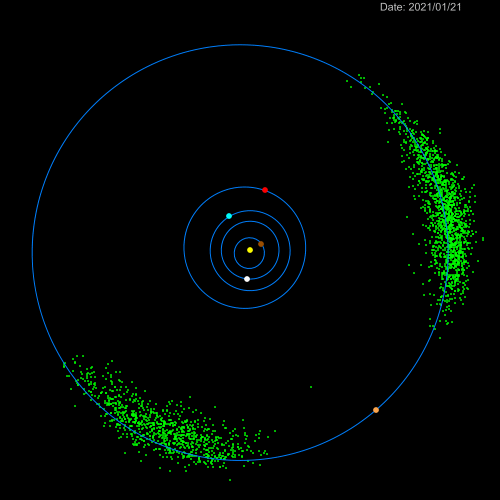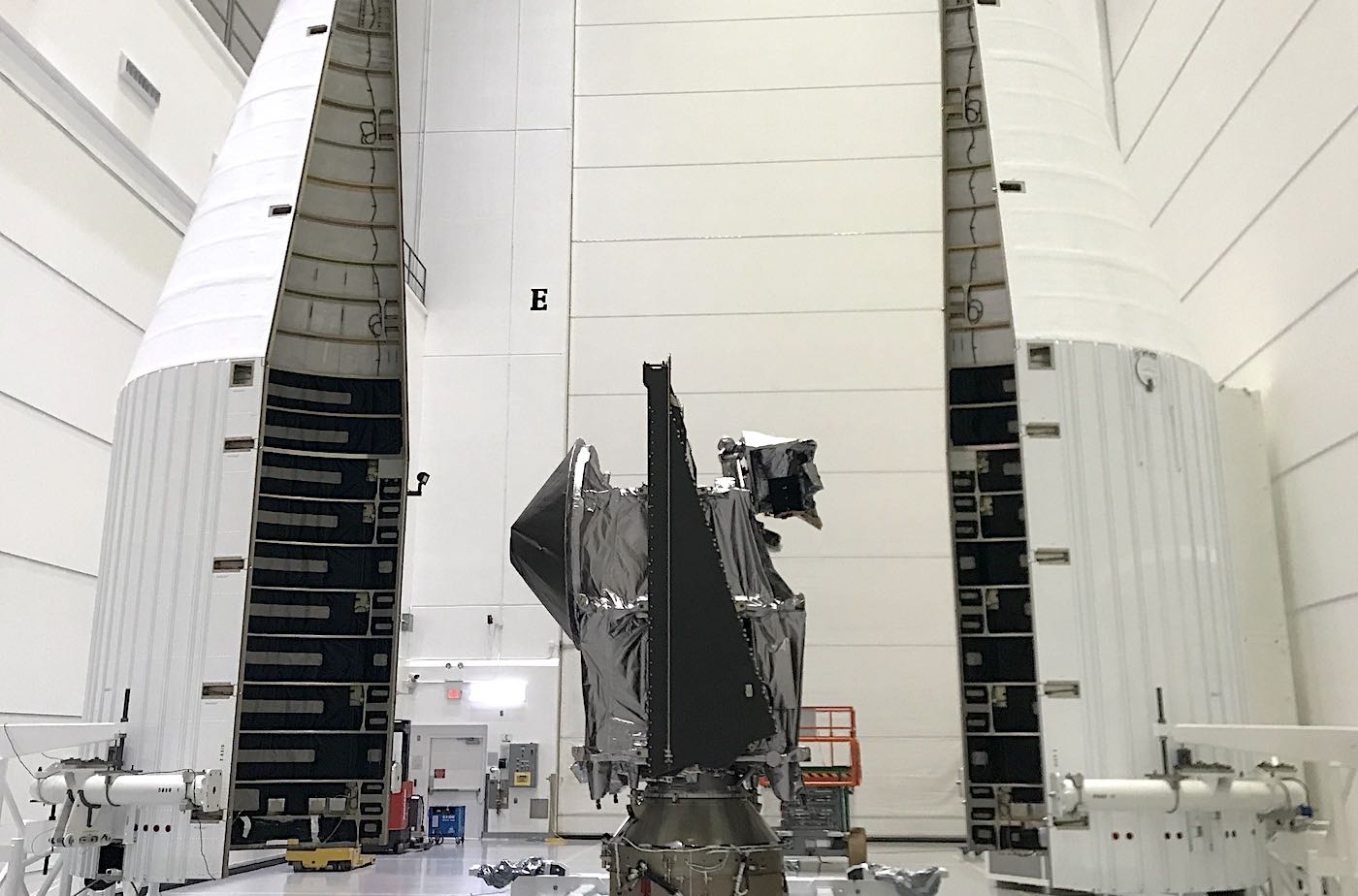Space News & Blog Articles
NASA’s Lucy asteroid mission 10 days from launch
 NASA’s Lucy spacecraft is prepared for encapsulation last month inside the payload shroud of its Atlas 5 launcher. Credit: NASA/Ben Smegelsky
NASA’s Lucy spacecraft is prepared for encapsulation last month inside the payload shroud of its Atlas 5 launcher. Credit: NASA/Ben Smegelsky
Fueled up for a 12-year mission of exploration, NASA’s Lucy science probe is nearly ready for launch Oct. 16 from Florida’s Space Coast to begin a journey through the solar system to visit eight asteroids, a record number for a single mission.
Ground teams completed testing of the Lucy spacecraft last month inside a climate-controlled clean room at the Astrotech payload processing facility in Titusville, Florida, a few miles from the gates to NASA’s Kennedy Space Center.
The tests capped a two-month campaign at Astrotech since the Lucy spacecraft arrived from its Lockheed Martin factory in Colorado. Technicians loaded hydrazine and nitrogen tetroxide propellants into the probe to feed its small maneuvering thrusters and main engine, which will help steer Lucy toward its asteroid targets.
“Lucy is done, and we’re ready to fly,” said Hal Levison, the mission’s principal investigator from the Southwest Research Institute, or SWRI, in Boulder, Colorado.
The $981 million mission will be the first to explore a population of asteroids called the Trojans, which orbit the sun ahead of and behind Jupiter.
Scientists believe the Trojan asteroids represent a diverse sample of the types of small planetary building blocks that formed after the solar system formed 4.5 billion years ago. Lucy will fly by eight different asteroids from 2025 through 2033, including seven in the Trojan swarms.
The 3,300-pound (1,500-kilogram) Lucy spacecraft is scheduled for launch aboard an Atlas 5 rocket Oct. 16 during a 75-minute window opening at 5:34 a.m. EDT (0834 GMT). The mission has 23 days to blast off and take advantage of a unique alignment between Earth and the asteroids in the outer solar system.
If something prevents launch this year, NASA has a backup opportunity to launch Lucy in October 2022 without any impact to the mission’s science goals.
But the launch campaign has run smoothly in Florida, and officials overcame hurdles associated with the COVID-19 pandemic to keep Lucy on schedule.
“The pandemic hit us a really inopportune time,” said Arlin Bartels, Lucy’s deputy project manager at NASA’s Goddard Space Flight Center. “It hit right when the instrument teams were just getting into their fabrication and into their testing.
“Over 400 components go into the spacecraft. We were still in the supply chain phase at that point. Planetary launch periods are very unforgiving in the best of circumstances because everything has to come and hit per schedule,” Bartels said. “Trying to do that during a pandemic like this is a very daunting situation, and I’m not sure that everyone, when the pandemic hit, thought we would be able to see this through on time.”
But engineers finished assembling the spacecraft, attached its three science instruments, completed construction of the probe’s fan-shaped solar arrays, and put Lucy through a battery of tests to ensure it will survive the rigors of launch and deep space operations.
“We’re not working anything on the spacecraft or the launch vehicle that concerns any of us at this moment,” said Omar Baez, NASA’s launch director for the Lucy mission.
Last Friday, United Launch Alliance completed a countdown dress rehearsal at Cape Canaveral. The launch team loaded kerosene, liquid hydrogen, and liquid oxygen propellants into the Lucy mission’s Atlas 5 rocket, verifying the launch vehicle and ground systems are ready for the real countdown.
“We came out of that test Friday evening in good shape, so the vehicle is ready to accept the encapsulated Lucy spacecraft,” Baez said. “So we’re ready to go.”
 Inside the Astrotech payload processing facility in Titusville, Florida, ground teams prepare to encapsulate NASA’s Lucy spacecraft inside the payload shroud of its Atlas 5 launcher. Credit: NASA/Ben Smegelsky
Inside the Astrotech payload processing facility in Titusville, Florida, ground teams prepare to encapsulate NASA’s Lucy spacecraft inside the payload shroud of its Atlas 5 launcher. Credit: NASA/Ben Smegelsky
While ULA tested the Atlas 5 rocket last week, workers in the Astrotech payload processing facility encapsulated the Lucy spacecraft inside the Atlas 5’s nose shroud. The aerodynamic fairing will shield the probe during final pre-launch preps, and protect the craft during the first few minutes of the climb into space.
The 13.8-foot-diameter (4.2-meter) payload fairing, produced by ULA in Harlingen, Texas, is emblazoned with the Lucy mission logo. The insignia features a pictorial illustration of the fossilized remains of a human ancestor, called Lucy by the scientists who discovered her in Ethiopia in 1974.
The Lucy skeleton became the namesake for the Lucy asteroid mission.
Like the fossil discovery informed scientists about human evolution, the Trojan asteroids could provide clues about the solar system’s ancient history. After Jupiter formed and settled into its current orbit, the asteroids became trapped in swarms, each centered on a gravitationally-stable libration point ahead of and behind the solar system’s biggest planet.
Lucy, the fossil, received its name after scientists heard the Beatles song “Lucy In The Sky With Diamonds” while celebrating the discovery. Scientists developing the Trojan asteroid explorer saw the connection.
“These asteroids really are like diamonds in the sky in terms of their scientific value for understanding how the giant planets formed and the solar system evolved,” Levison said.
“That fossil transformed our understanding of hominid evolution, just like we hope that the Lucy spacecraft will transform our understanding of solar system,” said Cathy Olkin, mission’s deputy principal investigator from SWRI.
Researchers believe the Trojan asteroids are the leftovers from the earliest period of the solar system’s history, when similar small objects clumped together to form the gas and ice planets of the outer solar system.
 During the course of its mission, Lucy will fly by seven Jupiter Trojan asteroids. This time-lapsed animation shows the movements of the inner planets (Mercury, brown; Venus, white; Earth, blue; Mars, red), Jupiter (orange), and the two Trojan swarms (green) during the course of the Lucy mission. Credit: Astronomical Institute of CAS/Petr Scheirich
During the course of its mission, Lucy will fly by seven Jupiter Trojan asteroids. This time-lapsed animation shows the movements of the inner planets (Mercury, brown; Venus, white; Earth, blue; Mars, red), Jupiter (orange), and the two Trojan swarms (green) during the course of the Lucy mission. Credit: Astronomical Institute of CAS/Petr Scheirich
“If all this story is true, and Lucy is going to test some of these hypotheses, these objects really do represent objects that formed throughout the outer solar system, and are now in the Trojan swarms, where a mission like Lucy can go and study them,” Levison said.
Scientists know little about the Trojan asteroids. Lucy will be the first spacecraft to ever fly through the Trojan swarms, where researchers have found more than 7,000 small objects. There may be thousands more awaiting discovery using large telescopes.
Even the Hubble Space Telescope can’t resolve details about the composition and appearance of the Trojan asteroids. Scientists have a rough approximation of the size of each object to be visited by Lucy, and know something about their colors.
After blasting off from Cape Canaveral, the Lucy spacecraft will spend a year in an orbit around the sun similar to Earth’s, before returning to its home planet next October for a gravity assist slingshot maneuver to begin heading out into the solar system.
A second flyby of Earth in December 2024 will send Lucy toward its first asteroid encounter. The spacecraft will speed past asteroid Donaldjohanson, named for the scientist who discovered the Lucy fossil, in April 2025.
Then Lucy will fly into the first Trojan swarm, visiting five asteroids — including a tiny moon of one of the objects — in just 15 months in 2027 and 2028.
 The Lucy spacecraft is seen Sept. 29 between the two halves of the Atlas 5 rocket’s payload fairing. Credit: Stephen Clark/Spaceflight Now
The Lucy spacecraft is seen Sept. 29 between the two halves of the Atlas 5 rocket’s payload fairing. Credit: Stephen Clark/Spaceflight Now
At its most distant arc, Lucy will be more than 500 million miles (800 million kilometers) from the sun. The spacecraft will be the farthest spacecraft from the sun to ever rely on solar power.
A final swing by Earth in 2030 will set up Lucy for the final encounter of the 12-year mission, a flyby of a binary pair of asteroids named Patroclus and Menoetius in March 2033. Each of the two objects are about the same size, with diameters of more than 60 miles (100 kilometers), making them the largest targets of Lucy’s solar system sojourn.
At each asteroid, Lucy will have just hours to take the best pictures and gather the most useful data. The probe will zip by the asteroids at a relative velocity of several miles per second, using a gimbaling instrument platform to point its camera and science instruments.
“Lucy is a flyby mission, so after spending years traveling more than a billion miles to get to our targets, we aim almost directly at them, flying within 600 miles (1,000 kilometers) of their surfaces,” said Keith Noll, NASA’s project scientist for the Lucy mission. “And Lucy doesn’t slow down for these flybys.”
This email address is being protected from spambots. You need JavaScript enabled to view it. the author.
Follow Stephen Clark on Twitter: @StephenClark1.
When you subscribe to the SpaceZE News Feed, we will send you an e-mail when there are new updates on the site so you wouldn't miss them.

